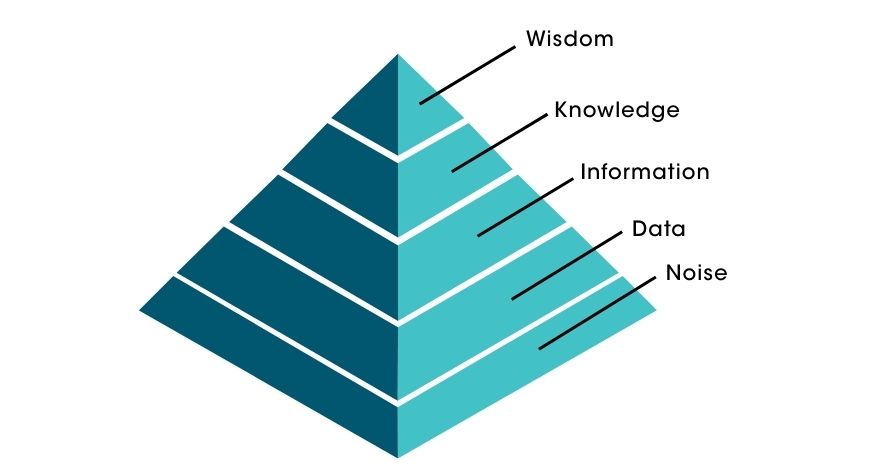It's Monday morning. You open your inbox and get flooded with newsletters, reports, and market insights. LinkedIn is full of opinions on the latest trends, and colleagues share research results you’re not sure you can trust. Meanwhile, your sales team says the market is picking up, while the finance department warns of a downturn.
Welcome to the information age. We've never had so much access to data, yet it's never been harder to distinguish truth from noise.
Many companies believe that more data automatically leads to better decisions. But data in itself is worthless if it is not interpreted and applied correctly. This is where the information pyramid comes into play. This model shows how you go from a jumble of information to strategic wisdom.

The invisible layer: noise
The classic DIKW hierarchy (data, information, knowledge, wisdom) describes how raw data is transformed into useful insights. But before we even get to data, there is a more fundamental step that is often overlooked: filtering out the noise.
Noise is everywhere. It's unfounded opinions, fake news, misinterpreted numbers, and uncontrolled assumptions. On social media, noise spreads faster than facts. Algorithms push messages that generate engagement, not necessarily the truth. And in business, decisions are often made based on incomplete, outdated data or gut feelings.
The dangers of noise
A company that buys a list of leads without validating it can waste thousands of euros on campaigns that deliver no results. A sales manager who claims that the competition is doing better can cause panic, while the facts tell a different story.
The solution? Fact-checking. Don't blindly trust what you read. Ask yourself: where does this information come from? Is the source reliable? Only by filtering out noise can you use data as a foundation.
Interesting read: No-code data integration is the future
From raw data to usable information
Once noise is eliminated, you move on to data: raw, objective facts. These can include revenue figures, the number of employees in a company, or the recorded business activities.
Data without context, however, means nothing. A list of companies may seem useful, but without knowing whether the data is up-to-date and accurate, it's just a pile of numbers.
To make data usable, it must be structured and placed in context. This leads to information. A list of companies only becomes relevant when you segment it based on sector, size, or growth potential.

The pitfall of misinterpretation
Many companies make mistakes in this phase. For example, an organization is classified as an 'industry' because that's how it's listed in a database, while in reality, it is an IT consultancy. A revenue of €50 million sounds impressive, but is that on a local or global scale?
Carefully analyzing and interpreting data is crucial. Meaning only arises when data is correctly organized and compared.
From insight to strategy
When information is combined and analyzed, knowledge is created. This is the moment when patterns become visible, and companies truly gain control over their market.
For example, a marketing department discovers that companies in the IT sector with more than 50 employees have a higher conversion rate than companies in other sectors. This is an insight that leads to better decisions.
Knowledge only becomes valuable when it is applied. And that brings us to the top of the pyramid: wisdom.
Interesting read: How to use integrations to shift from a traditional to an innovative sales approach - Altares
The power of wisdom in B2B
Wisdom is the ability to make the right decisions based on knowledge. This is where companies can make a difference.
An organization that understands its customer data well can:
- Distribute its marketing budget optimally across the most promising target groups,
- Focus its sales efforts on prospects with the highest conversion potential.,
- Identify market trends earlier and anticipate them.
Companies that continue to rely on gut feeling or outdated insights are falling behind. Data-driven organizations have an edge because they not only have information but also interpret and apply it correctly.
Why this model is essential
Many organizations get stuck at the lower levels of the pyramid. They collect data, structure it somewhat, but fail to convert it into actionable insights and strategic actions.
Anyone who truly wants to leverage data must consciously go through each level of the pyramid:
- Eliminate noise – Work only with reliable sources.
- Collecting and verifying data – Make sure the facts are correct and up-to-date
- Structure information – Give meaning to data by establishing connections.
- Build knowledge – Recognize patterns and analyze trends.
- Apply wisdom – Use insights to make strategic decisions.
By following these steps, you build a foundation for truly informed decisions. In business. And in the world beyond.
How well is data in your organization transformed into true wisdom?
